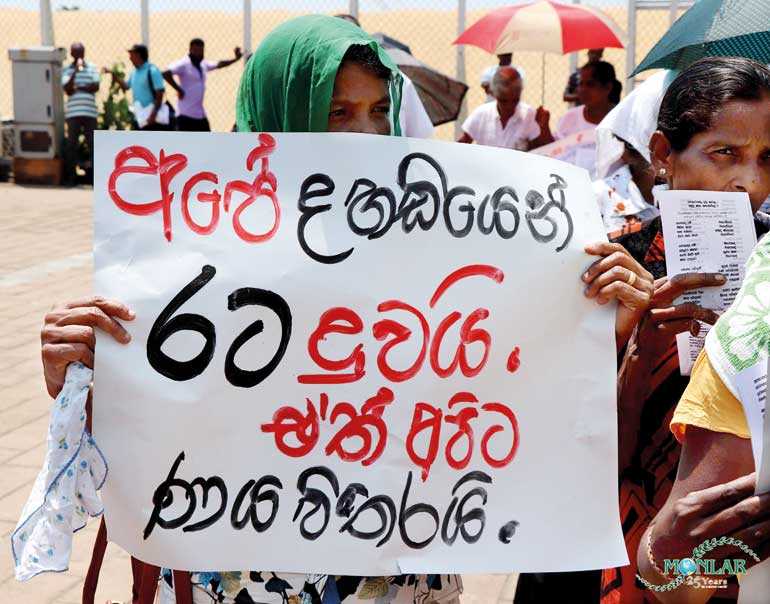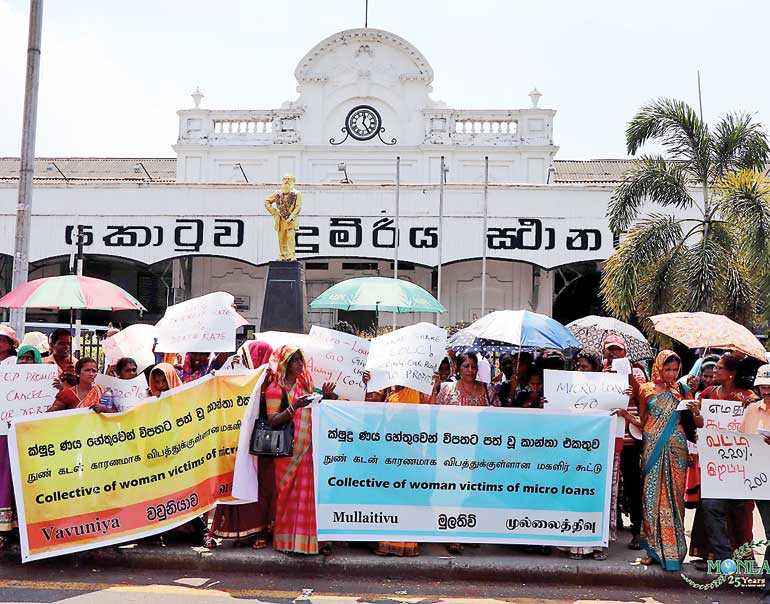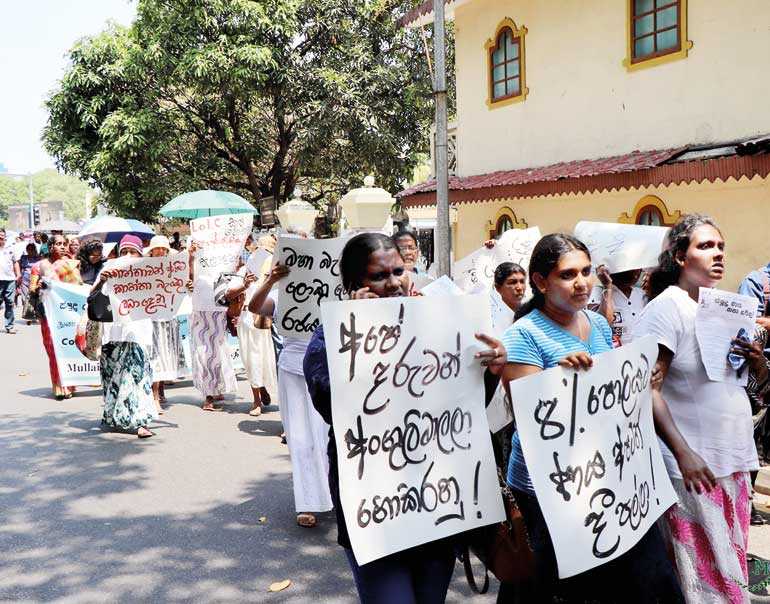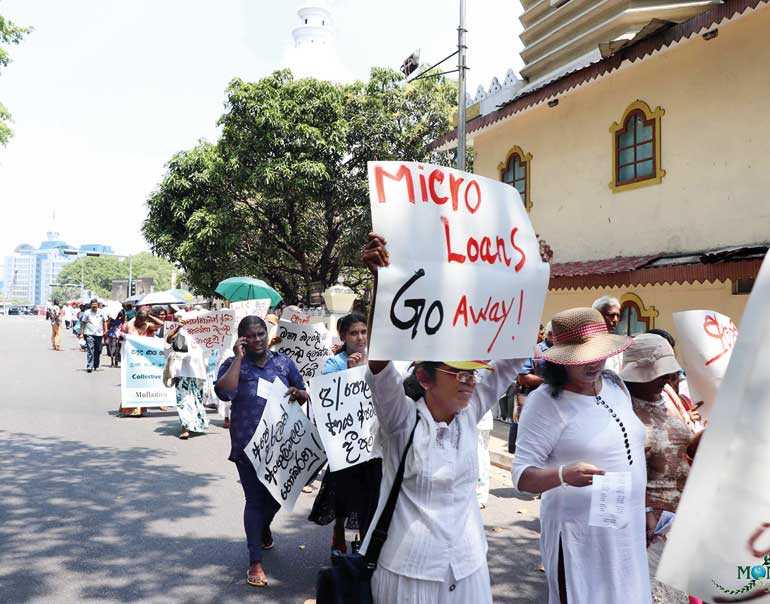Thursday Jan 08, 2026
Thursday Jan 08, 2026
Wednesday, 4 March 2020 01:00 - - {{hitsCtrl.values.hits}}

By Amali Wedagedara
More than 700 women from 14 districts came to Colombo on 27 February to protest against Government inaction on the microfinance debt crisis. Recalling a popular election slogan during the last Presidential Election, they demanded that the promise be kept, and microfinance debt be cancelled.
Calling out on the exploitative practices of lending by microfinance companies (MFIs), the victims of microfinance loans demanded that the MFIs be substituted with co-operatives to address their daily savings and credit needs.
One might wonder, “Why should these debts be cancelled if one has to honour his/her debt?” “How feasible is it to cancel these debts?” One could also ask, “Would more loans, let’s say low-interest ones, be the answer?” This article attempts to engage these questions. What is the scope of the microfinance crisis in Sri Lanka? What are the answers?
Other than cancelling microfinance debt, the other most popular election slogan was ‘entrepreneur-driven development’.
“Be an entrepreneur. Contribute to development,” people were told. The assumption that the supply of credit to self-relying and disciplined individuals will pave them an opportunity to discover the hidden entrepreneur within themselves is also at the heart of microfinance business.
How did a process that was supposed to kindle entrepreneurial spirits lead to over-indebtedness? Is it consumerism? Why do these people engage in wasteful expenditure on beetle nuts and alcohol? How else could these villagers get mired in a web of debt when they could have led more economical and sustainable lives?
The Household Income and Expenditure Survey produced by the Department of Census and Statistics provides some sense to the nature of household expenses across districts. Housing, transport, healthcare and education feature prominently among the household expenditures. Leave alone tuition classes, parents have started to incur substantial costs from public schools, even for those activities such as renovation and infrastructure development that should be funded either by the Government or Provincial Councils. The same thing applies to healthcare.
As one goes away from the urban or semi-urban areas, three wheels have replaced bus transport. Either one chooses to walk, cycle or use three wheels. In the outskirts of the urban areas such as Maharagama and Negombo people without steady incomes get into debt just to meet housing advances.
Then there are new expenses. A large number of people in the dry zone rely on filtered water. An average family of four has to spend about Rs. 1,000 per month if we price one litre of water at Rs. 1.75. It could also go up to Rs. 2. Crop damages due to floods, droughts and pests is another problem that these people face.
As one moves away from the capital and major cities, socialised costs of fiscal consolidation begin to hit hard. The problem is that lives also get more precarious when one moves away from the big cities. People who live on bare minimum without a permanent income are forced to shoulder spread effects from national budget cuts on education, healthcare and public transport.

Calling out on the exploitative practices of lending by microfinance companies (MFIs), the victims of microfinance loans are demanding that the MFIs be substituted with co-operatives to address their daily savings and credit needs
The most predictable response to the household debt crisis is to advocate financial literacy.
The Central Bank of Sri Lanka, the pioneering institute to regulate the financial companies and banks, carries out a series of workshops and newspaper advertisements educating the public on the importance of making sound financial decisions, how to avoid fraudulent finance companies and avoiding the various financial services in the informal sector such as multi-level marketing.
At one level, it is correct to say that ordinary people lack financial literacy. Most of the borrowers come from low-income, extremely vulnerable groups lacking formal education. They do not understand the language, various terms of transactions and even consequences.
While the lack of knowledge on financial transactions is widely known, the microfinance companies have exploited it to their advantage. None of the microfinance borrowers has a copy of the agreement with them. Many of the agreements they had signed have been in English, a language that they do not comprehend. The loan officers had not taken time to read and explain the nature of the agreement that they enter into. Many said that they were only asked to sign in multiple places. This is a grave oversight given the legalistic nature of the financial agreements.
Many microfinance companies do not mention the interest rate explicitly. It is couched within the monthly/ weekly payment. The companies have started to issue payment slips that fade away with time. As a result, many of the borrowers do not have a way to keep track of their loan payments. Keeping the people illiterate and uneducated on certain matters permits the powerful to dominate. This certainly has been relevant to the finance companies.

The microfinance programmes, premised on the assumption that everyone is a natural entrepreneur, cater to the credit needs of the ‘unbanked’ or the ‘risky’ kind who are without a regular income or assets.
The risks in lending justify dumping risks on the borrowers. So, the MFIs charge extremely high interests which are now capped at 35% after a series of protests by microfinance loan victims. Even at the capped rate, it is the highest interest rate for any loan disbursed by banks and finance companies in Sri Lanka and it is also the highest by South Asian standards. Even though the effective rate is capped at 35%, some companies continue to charge interest rates exceeding 35%.
While talking to a group of microfinance borrowers I learnt that some companies start recovery immediately after disbursing the loan. How could one expect to generate a turnover within two weeks’ time? And what type of investment could generate a turnover higher than 35%, so the borrower would not be forced into multiple loans?
I also found that almost all the microfinance lenders deduct the first payment when they disburse the loan. For example, a woman who applies for a loan of 100,000 only receives Rs. 100,000 minus the first monthly/weekly payment.
In some cases, borrowers meet with unexpected accidents. In one of the villages in Jaffna, a woman bought two cows, but the cows had died after about six months. In many other cases, family members, especially husbands, have met with accidents. Even though these loans are insured, the benefits of the insurance are limited to the company and do not cover the vulnerabilities of the borrower. Therefore, microfinance lending is structured to force borrowers to rely on multiple loans, not only from other microfinance companies but also from lenders in the informal market such as money lenders.
Even if one turns a blind eye to the question of turnover and ups and downs in life, could everyone who borrows from microfinance companies become entrepreneurs? Or in simple language, successful businessmen/women? What about the basic skills required to run a business? In many cases, I was told that the loan officers themselves produced the project reports. People merely signed on multiple locations. What about basic infrastructure such as markets? And if there is a market, what about the shocks in the market?
One old woman from Diya Beduma in Polonnaruwa took a microfinance loan in 2019 to produce ‘puhul dosi’ (candied silver melon) but the business failed after the Easter Sunday attacks. The Government provided a relief package to hotels and other institutions operating in the tourism sector in the aftermath of the attacks. However, small people had to bear the brunt of the economic crisis by themselves. Despite the lack of protection, these small people make the biggest contribution to the Sri Lankan economy.
The fact that the garment workers ($ 5 billion), housemaids in the Middle East ($ 3.6 billion), and tea plantation workers ($ 1.4 billion) are among the most productive contributors to the economy has escaped the attention of the policymakers. The smallholding farmers and fishers contribute about 80% of the total agricultural production. Yet, many of them are over-indebted and lead precarious lives.
The Cabinet decisions on 27 February reveal a possible attempt to address the microfinance crisis through co-operatives. The Cabinet has decided to extend the co-op driven loan programme to the North-Central Province and increase the loan amount to Rs. 60,000 per individual.
The victims of microfinance loans welcome a co-operative style intervention. They demanded that MFIs be replaced by co-ops. The co-operative movement in the Northern Province has been able to push back against the microfinance companies and address immediate credit needs of the people. However, in the south co-operatives have deteriorated due to long neglect. Instead of addressing and organising the village level economy, co-operatives in the south have ended up being political platforms.
Through co-ops or not, could loans be the answer to the current problem? Even though no one knows the scale of the crisis frequent suicides related to microfinance loans indicate the depth of the problem. Two women from Jaffna committed suicide in 2020 alone. The total number of deaths related to microfinance is estimated to be more than 200.
A majority in low-income households are in the CRIB (the Central Information Bureau) unable to access their credit needs from the formal financial markets, therefore are exposed to be exploited by the money lenders and other predatory lenders in the informal market. Many of the borrowers who are unable to pay are charged with legal action by finance companies and these money recovery cases are flooding district courts all around Sri Lanka.
We are now in a situation that cannot be remedied through further loans. These debts have to be waived off. At least, there has to be a long-term moratorium, so these people would have space to breathe and restart. The Government has to seriously rethink its policy of fiscal consolidation and step up with investments on people’s economy and public services. It is high time we turn the entrepreneurial slogan on its head. It is time for the State to take back the reigns of the economy and become the entrepreneur.
The writer is a PhD student in the University of Hawaii, Manoa, researching on low income household debt problem in Sri Lanka. She could be contacted via email at [email protected]
